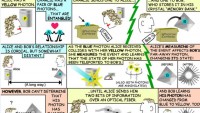Sandia, Harvard Research Team Creates First Quantum Computer Bridge
| Arthur Dominic Villasanta | | Oct 14, 2016 11:22 PM EDT |
(Photo : Sandia National Laboratories) This image shows an array of holes (purple) etched in diamond, with two silicon atoms (yellow) placed between the holes.
By forcefully embedding two silicon atoms in a diamond matrix, a joint team of researchers has demonstrated for the first time on a single chip all the components needed to create a quantum bridge to link quantum computers together.
The joint work between Sandia National Laboratories and Harvard University used a focused ion beam implanter at Sandia's Ion Beam Laboratory designed for blasting single ions into precise locations on a diamond substrate.
Like Us on Facebook
Distributing quantum information on a bridge, or network, could enable novel forms of quantum sensing, since quantum correlations allow all the atoms in the network to behave as though they were one single atom.
Harvard researchers performed the experiment, as well as the optical and quantum measurements. Sandia did the novel device fabrication and came up with a clever way to count exactly how many ions are implanted into the diamond substrate.
Sandia researchers Ed Bielejec, Jose Pacheco and Daniel Perry used implantation to replace one carbon atom of the diamond with the larger silicon atom, which causes the two carbon atoms on either side of the silicon atom to feel crowded enough to flee.
That leaves the silicon atom a kind of large landowner, buffered against stray electrical currents by the neighboring non-conducting vacancies.
"People have already built small quantum computers," said Sandia researcher Ryan Camacho. "Maybe the first useful one won't be a single giant quantum computer but a connected cluster of small ones."
Though the silicon atoms are embedded in a solid, they behave as though floating in a gas, and therefore their electrons' response to quantum stimuli aren't clouded by unwanted interactions with other matter.
Camacho said that what they did was to implant the silicon atoms exactly where we want them.
"We can create thousands of implanted locations, which all yield working quantum devices, because we plant the atoms well below the surface of the substrate and anneal them in place," he said.
"Before this, researchers had to search for emitter atoms among about 1,000 randomly occurring defects -- that is, non-carbon atoms -- in a diamond substrate of a few microns to find even one that emitted strongly enough to be useful at the single photon level."
Once the silicon atoms are settled in the diamond substrate, laser-generated photons bump silicon electrons into their next higher atomic energy state. When the electrons return to the lower energy state, because all things seek the lowest possible energy level, they spit out quantized photons that carry information through their frequency, intensity and the polarization of their wave.
Sandia researcher John Abraham and other Sandia researchers developed special detectors -- metal films atop the diamond substrate -- that showed the ion beam implants were successful by measuring the ionization signal produced by single ions.
The work was published in the current issue of the journal, Science.
TagsSandia National Laboratories, Harvard University, quantum bridge, quantum computers
©2015 Chinatopix All rights reserved. Do not reproduce without permission
EDITOR'S PICKS
-

Did the Trump administration just announce plans for a trade war with ‘hostile’ China and Russia?
-

US Senate passes Taiwan travel bill slammed by China
-

As Yan Sihong’s family grieves, here are other Chinese students who went missing abroad. Some have never been found
-

Beijing blasts Western critics who ‘smear China’ with the term sharp power
-

China Envoy Seeks to Defuse Tensions With U.S. as a Trade War Brews
-

Singapore's Deputy PM Provides Bitcoin Vote of Confidence Amid China's Blanket Bans
-

China warns investors over risks in overseas virtual currency trading
-

Chinese government most trustworthy: survey
-

Kashima Antlers On Course For Back-To-Back Titles
MOST POPULAR
LATEST NEWS
Zhou Yongkang: China's Former Security Chief Sentenced to Life in Prison

China's former Chief of the Ministry of Public Security, Zhou Yongkang, has been given a life sentence after he was found guilty of abusing his office, bribery and deliberately ... Full Article
TRENDING STORY

China Pork Prices Expected to Stabilize As The Supplies Recover

Elephone P9000 Smartphone is now on Sale on Amazon India

There's a Big Chance Cliffhangers Won't Still Be Resolved When Grey's Anatomy Season 13 Returns

Supreme Court Ruled on Samsung vs Apple Dispute for Patent Infringement

Microsoft Surface Pro 5 Rumors and Release Date: What is the Latest?













